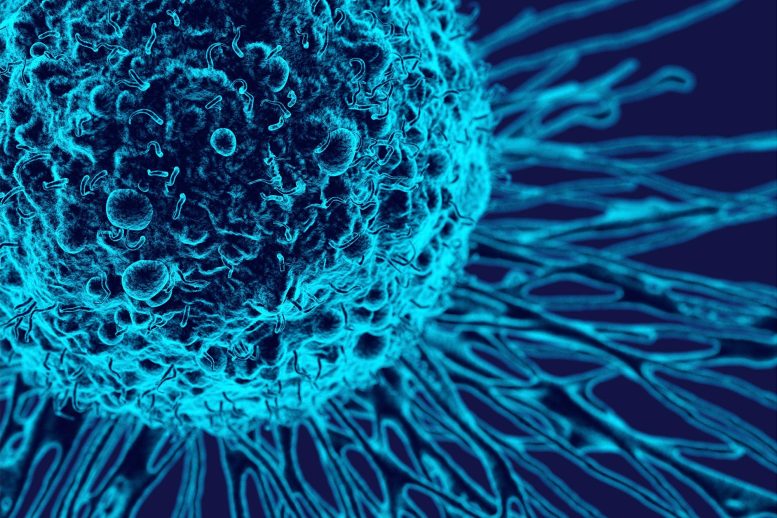
Early fallopian tube cell changes were found in a high‑risk patient. A live tissue bank and organoid system will help explore initial ovarian cancer development.
Very little is currently understood about the origins of ovarian cancer, and there are still no reliable methods for detecting it in its early stages. In approximately 75% of cases, the disease is only identified once it has already advanced to stage 3 or stage 4, meaning it has begun spreading beyond the ovaries. While seeking to better understand this difficult-to-detect cancer, Mayo Clinic physicians, researchers, and patients collaborated on an investigation that gained momentum when a 22-year-old woman with two rare inherited genetic mutations visited the clinic.
This patient had a hereditary BRCA2 mutation, linked to hereditary breast and ovarian cancer (HBOC) syndrome, as well as a TP53 mutation, the genetic cause of Li-Fraumeni syndrome—both of which dramatically increase lifetime cancer risk.

During her visit to Mayo Clinic, she was diagnosed with breast cancer. Imaging also revealed an ovarian cyst, which was ultimately found to be benign. Given her significantly elevated cancer risk, she decided to undergo both a mastectomy and a hysterectomy, along with the removal of her ovaries and fallopian tubes—a procedure known as bilateral salpingo-oophorectomy. After surgery, her care team examined her fallopian tube tissue and discovered subtle cellular abnormalities. These hidden changes may represent some of the earliest biological indicators of ovarian cancer, appearing well before any symptoms or visible signs of disease are present.
Single‑cell insights into precancerous changes
“Our team glimpsed a rare and revealing phenomenon in epithelial biology, uncovered through the cells of a young patient living with profoundly high-risk genetic conditions. Using cutting-edge, single-cell technologies, we traced how her epithelial cells were developmentally altered in ways that signaled a high risk for lethal ovarian cancer. These insights could pave the way for future strategies to detect the disease in its earliest, precancerous stages when prevention is still possible,” says Nagarajan Kannan, Ph.D., director of the Stem Cell and Cancer Biology Laboratory at Mayo Clinic and co-lead author of this study published in JCO Precision Oncology.
Jamie Bakkum-Gamez, M.D., the patient’s gynecologic oncology surgeon at Mayo Clinic, says she is determined to find a way to detect ovarian cancer earlier to help save more patients’ lives.
“We know that the most aggressive and common form of ovarian cancer often actually starts in the fallopian tube. However, why the fallopian tube and how it starts are not yet known. Knowing how ovarian cancer begins and forms could not only lead to the development of earlier screening tools, but also more personalized risk-reduction strategies and improved guidance around the timing of preventive surgeries and fertility planning,” says Dr. Bakkum-Gamez, who is a co-lead author of this study.

Dr. Kannan and Dr. Bakkum-Gamez have collaboratively developed a living fallopian tube biobank at Mayo Clinic. This resource, made possible through patient-donated cells and tissues, allows researchers to investigate the origins of ovarian cancer at the cellular level using actual human samples. From these specimens, scientists can grow organoids, which are miniature models of the fallopian tubes. The biobank contains organoids from individuals with varying levels of ovarian cancer risk, with a particular focus on inherited mutations such as those linked to HBOC syndrome and Li-Fraumeni syndrome.
“The precise cellular origin of ovarian cancer remains one of the greatest unanswered questions in cancer prevention — limiting our ability to intervene early and save lives. This work lays the foundation for a new era of early detection and precision prevention for ovarian cancer, especially for patients with inherited risk such as BRCA mutations,” says Dr. Kannan.
Ovarian cancer precursor

A healthy fallopian tube consists of two main types of epithelial cells: multiciliated cells that have hundreds of cilia, or hairlike appendages, that help move the fertilized egg through the fallopian tube, and secretory cells that secrete fluids to nourish and protect the developing embryo. But in the fallopian tube cells collected from the patient with HBOC syndrome and Li-Fraumeni syndrome, the scientists saw something they had never seen before. Instead of the two types of epithelial cells, the secretory cells vastly outnumbered the multiciliated cells across the fallopian tube. They also found that secretory cells were driving chronic inflammation, an established contributor to cancer development.
“Through single-cell RNA sequencing, we could see the disruptions in the development of cells lining the fallopian tube lumen — findings that could help reshape how we understand and ultimately prevent ovarian cancer,” says Megan Ritting, co-lead author and Mayo Clinic Graduate School of Biomedical Sciences doctoral candidate. Ritting spearheaded the use of cutting-edge genomic technology in this study.
Furthermore, oral contraceptives containing progestins, or synthetic analogs of the hormone progesterone that is produced by the ovaries, can be used to reduce ovarian cancer risk by up to 50%. However, Ritting and the research team were surprised to see that this patient’s fallopian tube cells did not have any progesterone receptor proteins, which suggests oral contraceptives may not have been effective in reducing the patient’s risk for ovarian cancer.
“With the generous partnership of patients who allow their cells to be studied using advanced technologies, including organoid models, we are making critical progress in understanding how these cancers develop. This work represents an important step toward identifying opportunities to develop preventive strategies, treatments, and approaches that could reduce the risk of fallopian tube and ovarian cancers,” says Dr. Bakkum-Gamez.
In the next steps of this research, using the living fallopian tube biobank, the scientists are investigating how and where the earliest origins of ovarian cancer take root.
Reference: “Epithelial Abnormalities in the High-Risk Fallopian Tube of a Rare TP53/BRCA2 Li-Fraumeni Syndrome Patient With Multiple Tumors” by Megan L. Ritting, Simrit K. Warring, Manuel M. Bettencourt, Syed Mohammed Musheer Aalam, Maryam Shahi, Fergus J. Couch, Jamie N. Bakkum-Gamez and Nagarajan Kannan, 24 June 2025, JCO Precision Oncology.
DOI: 10.1200/PO-24-00589
Never miss a breakthrough: Join the SciTechDaily newsletter.